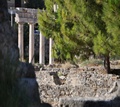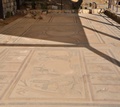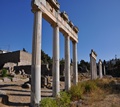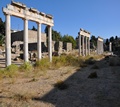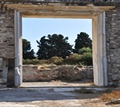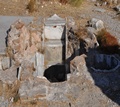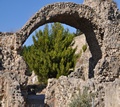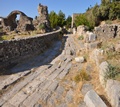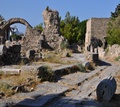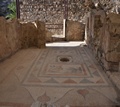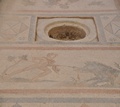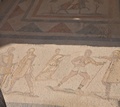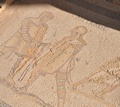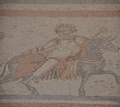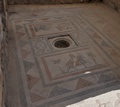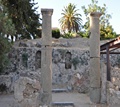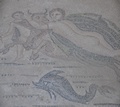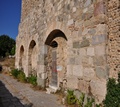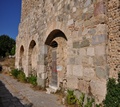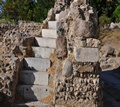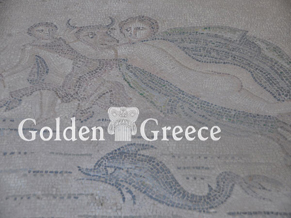
The so-called Western Archaeological Site is located in the center of the town of Kos.
Among others, part of the Gymnasium, the Western Baths, the "Nymphaeum", the house of Europe, the house of Silenus, the mosaic of the Judgment of Paris, two early Christian basilicas and the intersection of the two main streets of the ancient city have been discovered in the area. .
The buildings that were discovered span a wide period of time that extends from the time of the settlement of Kos (4th century BC) until its destruction in 554 AD. A part of the pre-existing Mycenaean city was also found, as well as geometric tombs.
The most important findings are:
Neosoiki: were buildings where ships were kept when not in use. Also, in the area of the port of Kos, the ancient neorion (navsthamos) was found.
Thermes limenos: They are located on Herodotou Street and their masonry technique dates them to the 3rd AD. century. It consisted of a circular hall with arcades and walls of heat-insulating bricks. Mosaic floors from the 5th-6th AD were found to the west and north of Therme of Limenos. century.
Stadium: it is located between the northern Thermes and the western Gymnasium and is oriented from NW to SW. Its shape was a parallelogram and not the usual horseshoe.
North Thermes: date back to the 3rd century AD. It was a large building with a long hall with arches and domes. In their D section are the hypocausts and next to them various architectural elements and inscriptions were found, the most important of which is the regulation of the cult of Enagoni Hermos. These findings suggest the existence of a neighboring Hellenistic Northern Gymnasium, which has not been identified.
The Ancient Acropolis on which it was found by excavation that a settlement of the Early Bronze Age (third millennium BC) had developed. during Roman times, when it had lost its defensive role, luxurious houses were built on the height of the acropolis.
The western Gymnasium, which is a building of the Hellenistic period, was in direct contact with the stadium, from which it was separated by a narrow street 1.20m wide. It was a large rectangular building (dimensions 200m by 120m) with a peristyle inner courtyard and was used for sports during the winter. Also, 17 of the estimated 81 columns that the eastern portico of the building had were uncovered and restored. The building was destroyed by an earthquake that occurred in AD 469. The mosaic floor of the Western Gymnasium is one of the largest that have been uncovered in Kos. The mosaic decoration is divided into 3 panels, which are surrounded by representations of beast battles. The right panel is damaged and in the central one a Centaur with a lyre and the figures of Psyche or the Moon are just discernible. In the left panel is depicted the judgment of Paris, when he offered the apple of Eris to the Goddess Aphrodite and caused the Trojan War. In the two zones, above and below the frame, the 9 Muses and the God Apollo (in the center of the bottom pentacle) are depicted arranged in two pentacles.
The Western Baths which were built in the 3rd century AD in the southern part of the Western Gymnasium, in a trapezoidal shape. They occupied the hall spaces behind the east portico of the West Gymnasium and extended almost half the length of its east wing. Today a part of the vaulted roof and a restored door survive. The building of Thermae was severely damaged in the earthquake of 469 AD and since then a part of it has been converted into an early Christian basilica
Ancient street (cardo) which dates back to the 3rd century. AD It is made of almond stone (or travertine, a type of limestone) and there are sidewalks on either side of its carriageway. A sewer runs under the carriageway, while water pipes were found in the masonry above the western (right) pavement.
The Nymphaeum is actually a building of public urinals (the name was given as a euphemism). It is located almost opposite the western Thermal Baths. and dates back to the end of the 3rd century AD.
The great thoroughfare of the ancient city or "ancient arcaded street" or decumano massimo. In a direction from E to W it led outside the city walls.
The House of the "Rapture of Europa" was so named from the mosaic floor with the theme of the rapture of Europa by Jupiter transformed into a bull, which adorns one of its rooms. In one of its rooms a mosaic (3 x 3.2 m.) was found showing the naked nymph Europa being carried in the waves held by the horns of the bull - Zeus. In the well-preserved rooms of the house, mosaics are preserved - columns, column bases and drainage installations of remarkable technical execution.
The original construction of this house dates back to Hellenistic times, at the end of the 3rd or the beginning of the 2nd century. BC X. Part of the decoration of this house was a series of remarkable statues, which date back to the 2nd AD. century (Roman era) and are exhibited in the Archaeological Museum of Kos.
In one of the statues, Hygeia is represented holding a large snake with her right hand while offering it an egg with her left. At her feet is Cupid-Sleep. Another statue depicts the god Dionysus, who rests with his left hand on a trunk around which a vine winds, while on top of it the god Pan can be seen playing the syringe. Dionysus' right hand holds a cup and embraces a Satyr. At their feet sits Erotideas (little Cupid) playing with a panther. The house of the rapture of Europe has been restored and can be visited.
The House of Silinos, which is kept in very good condition, is completely covered to protect the frescoes and the mosaic that adorns its floor. In the upper panel of the mosaic is depicted a bearded Silenus dressed in chlamys and mantle, girded with ivy, holding a thyrsus and sitting comfortably on the back of a mule. In the lower panel is depicted gladiators training and in the center their trainer with a palm branch. The names of the two on the right (Zefyros and Hylas) and the one on the left (Aigialos) can be distinguished.
Editor: Fotini Anastasopoulou










